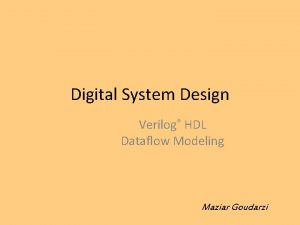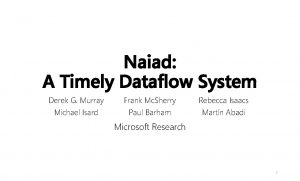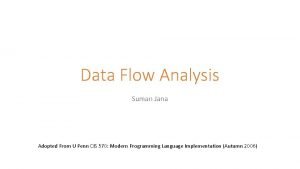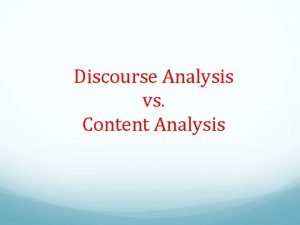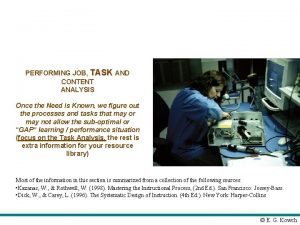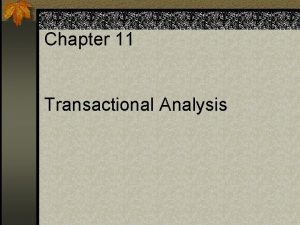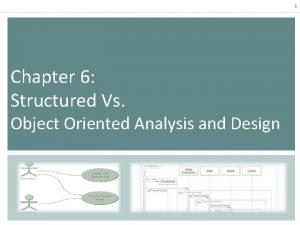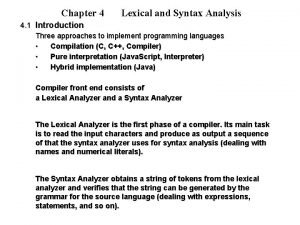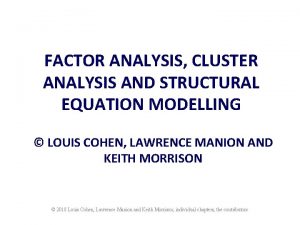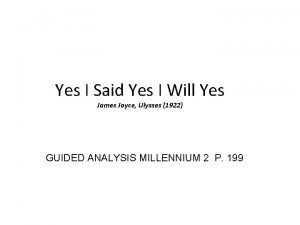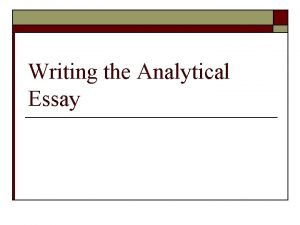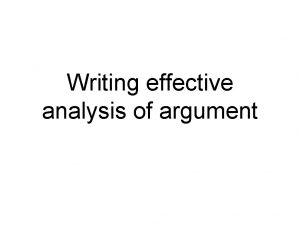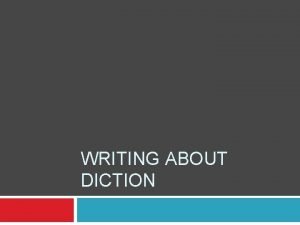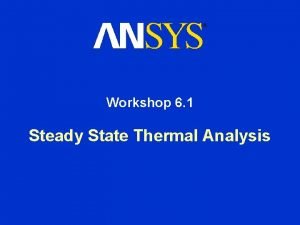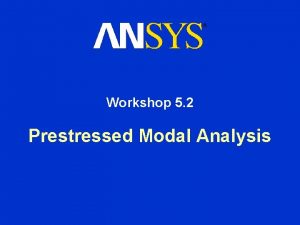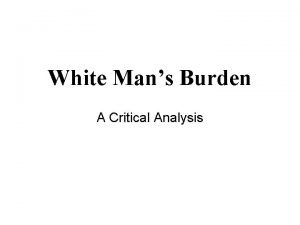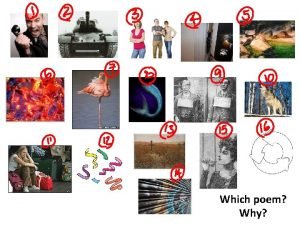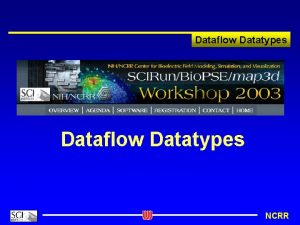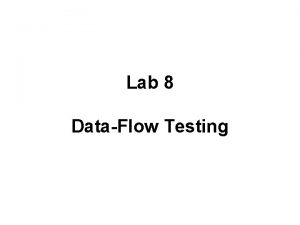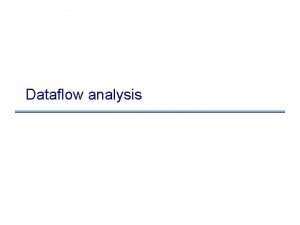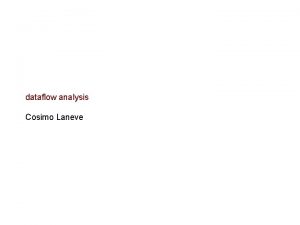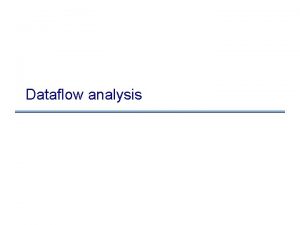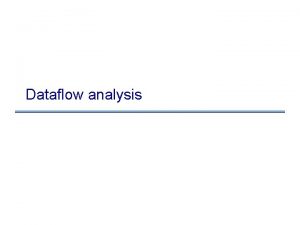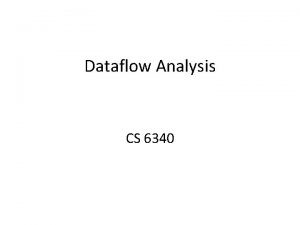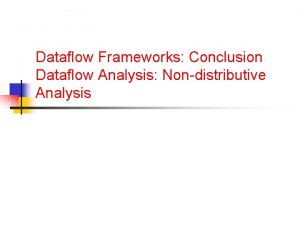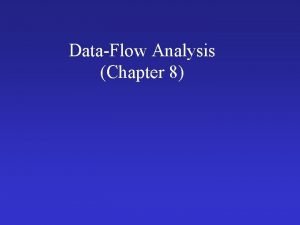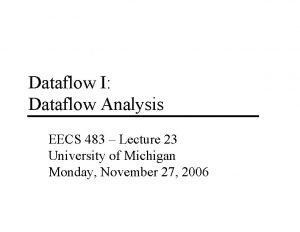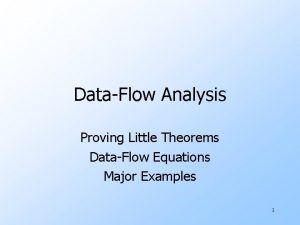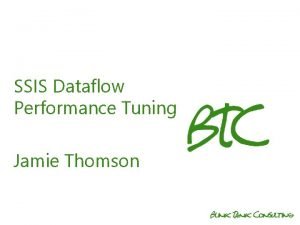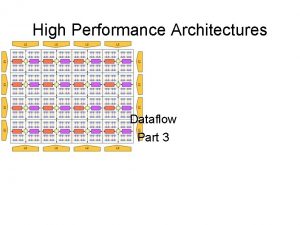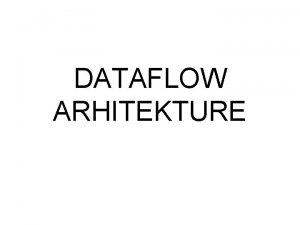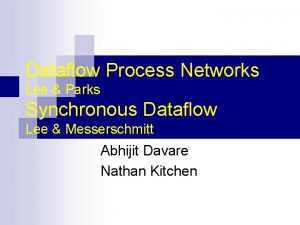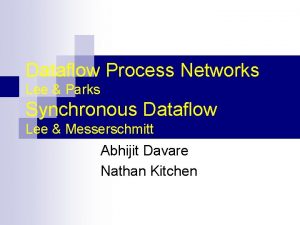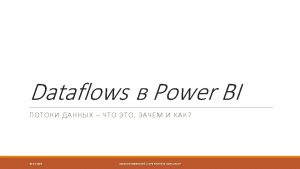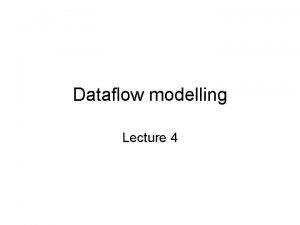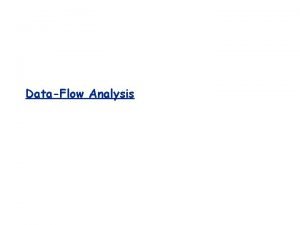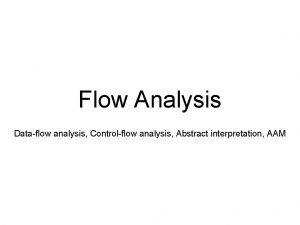Dataflow analysis Dataflow analysis what is it A


















![Constraints for reaching definitions in s: if (. . . ) out[0] out[1] in[0] Constraints for reaching definitions in s: if (. . . ) out[0] out[1] in[0]](https://slidetodoc.com/presentation_image_h/05a60a67420f6432b627ed2281ea9ba4/image-19.jpg)
![Constraints for reaching definitions in s: if (. . . ) out[0] in[0] out Constraints for reaching definitions in s: if (. . . ) out[0] in[0] out](https://slidetodoc.com/presentation_image_h/05a60a67420f6432b627ed2281ea9ba4/image-20.jpg)

























- Slides: 45

Dataflow analysis

Dataflow analysis: what is it? • A common framework for expressing algorithms that compute information about a program • Why is such a framework useful?

Dataflow analysis: what is it? • A common framework for expressing algorithms that compute information about a program • Why is such a framework useful? • Provides a common language, which makes it easier to: – – communicate your analysis to others compare analyses adapt techniques from one analysis to another reuse implementations (eg: dataflow analysis frameworks)

Control Flow Graphs • For now, we will use a Control Flow Graph representation of programs – each statement becomes a node – edges between nodes represent control flow • Later we will see other program representations – variations on the CFG (eg CFG with basic blocks) – other graph based representations


An example DFA: reaching definitions • For each use of a variable, determine what assignments could have set the value being read from the variable • Information useful for: – – performing constant and copy prop detecting references to undefined variables presenting “def/use chains” to the programmer building other representations, like the DFG • Let’s try this out on an example




Safety • When is computed info safe? • Recall intended use of this info: – – performing constant and copy prop detecting references to undefined variables presenting “def/use chains” to the programmer building other representations, like the DFG • Safety: – can have more bindings than the “true” answer, but can’t miss any

Reaching definitions generalized • DFA framework geared to computing information at each program point (edge) in the CFG – So generalize problem by stating what should be computed at each program point • For each program point in the CFG, compute the set of definitions (statements) that may reach that point • Notion of safety remains the same

Reaching definitions generalized • Computed information at a program point is a set of var ! stmt bindings – eg: { x ! s 1, x ! s 2, y ! s 3 } • How do we get the previous info we wanted? – if a var x is used in a stmt whose incoming info is in, then:

Reaching definitions generalized • Computed information at a program point is a set of var ! stmt bindings – eg: { x ! s 1, x ! s 2, y ! s 3 } • How do we get the previous info we wanted? – if a var x is used in a stmt whose incoming info is in, then: { s | (x ! s) 2 in } • This is a common pattern – generalize the problem to define what information should be computed at each program point – use the computed information at the program points to get the original info we wanted



Using constraints to formalize DFA • Now that we’ve gone through some examples, let’s try to precisely express the algorithms for computing dataflow information • We’ll model DFA as solving a system of constraints • Each node in the CFG will impose constraints relating information at predecessor and successor points • Solution to constraints is result of analysis

Constraints for reaching definitions in s: x : =. . . out in s: *p : =. . . out

Constraints for reaching definitions in s: x : =. . . out = in – { x ! s’ | s’ 2 stmts } [ { x ! s } out in s: *p : =. . . out • Using may-point-to information: out = in [ { x ! s | x 2 may-point-to(p) } • Using must-point-to aswell: out = in – { x ! s’ | x 2 must-point-to(p) Æ s’ 2 stmts } [ { x ! s | x 2 may-point-to(p) }
![Constraints for reaching definitions in s if out0 out1 in0 Constraints for reaching definitions in s: if (. . . ) out[0] out[1] in[0]](https://slidetodoc.com/presentation_image_h/05a60a67420f6432b627ed2281ea9ba4/image-19.jpg)
Constraints for reaching definitions in s: if (. . . ) out[0] out[1] in[0] in[1] merge out
![Constraints for reaching definitions in s if out0 in0 out Constraints for reaching definitions in s: if (. . . ) out[0] in[0] out](https://slidetodoc.com/presentation_image_h/05a60a67420f6432b627ed2281ea9ba4/image-20.jpg)
Constraints for reaching definitions in s: if (. . . ) out[0] in[0] out [ 0 ] = in Æ out [ 1 ] = in out[1] more generally: 8 i. out [ i ] = in in[1] out = in [ 0 ] [ in [ 1 ] merge out more generally: out = i in [ i ]

Flow functions • The constraint for a statement kind s often have the form: out = Fs(in) • Fs is called a flow function – other names for it: dataflow function, transfer function • Given information in before statement s, Fs(in) returns information after statement s • Other formulations have the statement s as an explicit parameter to F: given a statement s and some information in, F(s, in) returns the outgoing information after statement s

Flow functions, some issues • Issue: what does one do when there are multiple input edges to a node? • Issue: what does one do when there are multiple outgoing edges to a node?

Flow functions, some issues • Issue: what does one do when there are multiple input edges to a node? – the flow functions takes as input a tuple of values, one value for each incoming edge • Issue: what does one do when there are multiple outgoing edges to a node? – the flow function returns a tuple of values, one value for each outgoing edge – can also have one flow function per outgoing edge

Flow functions • Flow functions are a central component of a dataflow analysis • They state constraints on the information flowing into and out of a statement • This version of the flow functions is local – it applies to a particular statement kind – we’ll see global flow functions shortly. . .

Summary of flow functions • Flow functions: Given information in before statement s, Fs(in) returns information after statement s • Flow functions are a central component of a dataflow analysis • They state constraints on the information flowing into and out of a statement

Back to example 1: 2: 3: 4: d 9 = Ff(d 4) x : =. . . y : =. . . p : =. . . if(. . . ) d 9 d 10 = Fj(d 9) d 11 = Fk(d 10) d 12 = Fl(d 11) d 10 d 11 d 2 d 3 d 4 d 1 = Fa(d 0) d 2 = Fb(d 1) d 3 = Fc(d 2) d 4 = Fd(d 3) d 5 = Fe(d 4) d 5 . . . x. . . 5: x : =. . . y. . . x. . . 6: x : =. . . 7: *p : =. . . d 12 How to find solutions for di? d 0 d 6 = Fg(d 5) d 6 d 7 = Fh(d 6) d 7 d 8 = Fi(d 7) d 8 merge. . . x. . . y. . . 8: y : =. . . d 13 = Fm(d 12, d 8) d 13 d 14 = Fn(d 13) d 14 d 15 = Fo(d 14) d 15 d = Fp(d 15) d 16 16

How to find solutions for di? • This is a forward problem – given information flowing in to a node, can determine using the flow function the info flow out of the node • To solve, simply propagate information forward through the control flow graph, using the flow functions • What are the problems with this approach?

First problem 1: 2: 3: 4: d 9 = Ff(d 4) x : =. . . y : =. . . p : =. . . if(. . . ) d 9 d 10 = Fj(d 9) d 11 = Fk(d 10) d 12 = Fl(d 11) d 10 d 11 d 2 d 3 d 4 d 1 = Fa(d 0) d 2 = Fb(d 1) d 3 = Fc(d 2) d 4 = Fd(d 3) d 5 = Fe(d 4) d 5 . . . x. . . 5: x : =. . . y. . . x. . . 6: x : =. . . 7: *p : =. . . d 12 What about the incoming information? d 0 d 6 = Fg(d 5) d 6 d 7 = Fh(d 6) d 7 d 8 = Fi(d 7) d 8 merge. . . x. . . y. . . 8: y : =. . . d 13 = Fm(d 12, d 8) d 13 d 14 = Fn(d 13) d 14 d 15 = Fo(d 14) d 15 d = Fp(d 15) d 16 16

First problem • What about the incoming information? – d 0 is not constrained – so where do we start? • Need to constrain d 0 • Two options: – explicitly state entry information – have an entry node whose flow function sets the information on entry (doesn’t matter if entry node has an incoming edge, its flow function ignores any input)

Entry node s: entry out = { x ! s | x 2 Formals }

Second problem 1: 2: 3: 4: d 9 = Ff(d 4) x : =. . . y : =. . . p : =. . . if(. . . ) d 9 d 10 = Fj(d 9) d 11 = Fk(d 10) d 12 = Fl(d 11) d 10 d 11 d 2 d 3 d 4 d 0 = Fentry() d 1 = Fa(d 0) d 2 = Fb(d 1) d 3 = Fc(d 2) d 4 = Fd(d 3) d 5 = Fe(d 4) d 5 . . . x. . . 5: x : =. . . y. . . x. . . 6: x : =. . . 7: *p : =. . . d 12 Which order to process nodes in? d 0 d 6 = Fg(d 5) d 6 d 7 = Fh(d 6) d 7 d 8 = Fi(d 7) d 8 merge. . . x. . . y. . . 8: y : =. . . d 13 = Fm(d 12, d 8) d 13 d 14 = Fn(d 13) d 14 d 15 = Fo(d 14) d 15 d = Fp(d 15) d 16 16

Second problem • Which order to process nodes in? • Sort nodes in topological order – each node appears in the order after all of its predecessors • Just run the flow functions for each of the nodes in the topological order • What’s the problem now?

Second problem, prime • When there are loops, there is no topological order! • What to do? • Let’s try and see what we can do



Worklist algorithm • Initialize all di to the empty set • Store all nodes onto a worklist • while worklist is not empty: – remove node n from worklist – apply flow function for node n – update the appropriate di, and add nodes whose inputs have changed back onto worklist

Worklist algorithm let m: map from edge to computed value at edge let worklist: work list of nodes for each edge e in CFG do m(e) : = ; for each node n do worklist. add(n) while (worklist. empty. not) do let n : = worklist. remove_any; let info_in : = m(n. incoming_edges); let info_out : = F(n, info_in); for i : = 0. . info_out. length-1 do if (m(n. outgoing_edges[i]) info_out[i]) m(n. outgoing_edges[i]) : = info_out[i]; worklist. add(n. outgoing_edges[i]. dst);

Issues with worklist algorithm

Two issues with worklist algorithm • Ordering – In what order should the original nodes be added to the worklist? – What order should nodes be removed from the worklist? • Does this algorithm terminate?

Order of nodes • Topological order assuming back-edges have been removed • Reverse depth-first post-order • Use an ordered worklist


Termination • Why is termination important? • Can we stop the algorithm in the middle and just say we’re done. . . • No: we need to run it to completion, otherwise the results are not safe. . .

Termination • Assuming we’re doing reaching defs, let’s try to guarantee that the worklist loop terminates, regardless of what the flow function F does while (worklist. empty. not) do let n : = worklist. remove_any; let info_in : = m(n. incoming_edges); let info_out : = F(n, info_in); for i : = 0. . info_out. length-1 do if (m(n. outgoing_edges[i]) info_out[i]) m(n. outgoing_edges[i]) : = info_out[i]; worklist. add(n. outgoing_edges[i]. dst);

Termination • Assuming we’re doing reaching defs, let’s try to guarantee that the worklist loop terminates, regardless of what the flow function F does while (worklist. empty. not) do let n : = worklist. remove_any; let info_in : = m(n. incoming_edges); let info_out : = F(n, info_in); for i : = 0. . info_out. length-1 do let new_info : = m(n. outgoing_edges[i]) [ info_out[i]; if (m(n. outgoing_edges[i]) new_info]) m(n. outgoing_edges[i]) : = new_info; worklist. add(n. outgoing_edges[i]. dst);

Structure of the domain • We’re using the structure of the domain outside of the flow functions • In general, it’s useful to have a framework that formalizes this structure • We will use lattices
 Data flow modeling in verilog examples
Data flow modeling in verilog examples Naiad dataflow
Naiad dataflow Suman jana
Suman jana Arbicor
Arbicor Procedural statement
Procedural statement Disadvantages of dfd
Disadvantages of dfd Cuckoo sandbox online
Cuckoo sandbox online Content analysis vs discourse analysis
Content analysis vs discourse analysis Difference between error analysis and contrastive analysis
Difference between error analysis and contrastive analysis Types of intralingual errors
Types of intralingual errors What is fact analysis
What is fact analysis Content analysis and task analysis
Content analysis and task analysis Child ego state
Child ego state Ooad vs ssad
Ooad vs ssad Syntax analyzer source code in java
Syntax analyzer source code in java Content analysis is a type of secondary data analysis
Content analysis is a type of secondary data analysis Candidate system in system analysis and design
Candidate system in system analysis and design Kmo test
Kmo test The eatonville anthology analysis
The eatonville anthology analysis Analisi swoy
Analisi swoy Young and dyslexic structure analysis
Young and dyslexic structure analysis Gross impertinence
Gross impertinence Yes i said yes i will yes with punctuation
Yes i said yes i will yes with punctuation Vce argument analysis
Vce argument analysis The messenger ed character analysis
The messenger ed character analysis Character of margie
Character of margie What is an analytical expository essay
What is an analytical expository essay I knew a simple soldier boy analysis
I knew a simple soldier boy analysis Argument analysis example
Argument analysis example Opvl analysis example
Opvl analysis example Literary elements of diction
Literary elements of diction Writing a character analysis essay
Writing a character analysis essay Example character analysis
Example character analysis The soldier rupert brooke theme
The soldier rupert brooke theme Steady state thermal analysis
Steady state thermal analysis Prestressed modal analysis ansys workbench
Prestressed modal analysis ansys workbench Picasso weeping woman analysis
Picasso weeping woman analysis Workforce analysis
Workforce analysis Gedig vir my ma
Gedig vir my ma Winter dreams analysis
Winter dreams analysis The little black boy william blake analysis
The little black boy william blake analysis Why be happy when you could be normal summary
Why be happy when you could be normal summary Whole foods market slogan
Whole foods market slogan The tables turned analysis
The tables turned analysis White mans burden analysis
White mans burden analysis Shopping trolley poem
Shopping trolley poem
